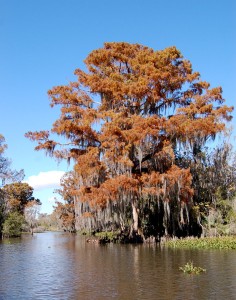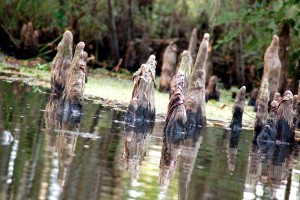Bald Cypress – Sentinels of the Swamp
 This article received a Excellence in Craft 1st Place award in Magazine Regular Feature from the Louisiana Outdoor Writers Association in 2014. I was very, very excited!!!
This article received a Excellence in Craft 1st Place award in Magazine Regular Feature from the Louisiana Outdoor Writers Association in 2014. I was very, very excited!!!
Deep in the swamp, the darkness of alluvial mud creates a reflective canvas on the surface of the still water, mirroring the images of bald cypress that tower above picturesque waterways throughout Louisiana. The statuesque trees are a staple of Louisiana wetlands and have deep utilitarian value to humans, wildlife, and the environment. As such, this stately tree was recommended as Louisiana’s official tree by a Baton Rouge fourth-grade class in 1962, with an official act of proclamation following in May 1963.
The term “bald,” an apt descriptor, comes from a unique winter event that sets this cypress apart from other conifers, which are evergreen. Unlike other conifers, the bald cypress’ needles turn a dark, burnt-orange in the fall before dropping off the branches during winter, leaving the tree “bald.”
 Able to thrive in standing freshwater, bald cypress grow wild in Louisiana’s swamps. They also grow on the fringes of freshwater lakes and ponds, and can now be seen as landscape features on dry ground.
Able to thrive in standing freshwater, bald cypress grow wild in Louisiana’s swamps. They also grow on the fringes of freshwater lakes and ponds, and can now be seen as landscape features on dry ground.
Cypress trees were once an historical construction mainstay for Louisiana natives and settlers. Heartwood of old-growth cypress contains cypressene oil, giving the wood valuable characteristics that enable it to thrive in the South Louisiana climate. The oil renders the wood rot-resistant, making it an ideal boat-building material; in the past, it was used to build pirogues as well as larger bateaus and skiffs. Also termite resistant, the old wood was ideal for building homes; and Acadian-style homes still standing today are proof of the lumber’s durability.
 In the early twentieth century, timber and lumber companies harvested hundreds of thousands of acres of cypress trees, which resulted in the depletion of the old-growth “virgin” cypress. In the heyday of cypress harvesting, the felled logs were floated out of the shallow swamps into deeper lakes or canals. En route to the lake, logs sometimes strayed from the tow and sank to the bottom, abandoned; however, the wood is so rot-resistant that these logs can still be found intact.
In the early twentieth century, timber and lumber companies harvested hundreds of thousands of acres of cypress trees, which resulted in the depletion of the old-growth “virgin” cypress. In the heyday of cypress harvesting, the felled logs were floated out of the shallow swamps into deeper lakes or canals. En route to the lake, logs sometimes strayed from the tow and sank to the bottom, abandoned; however, the wood is so rot-resistant that these logs can still be found intact.
 Having fallen to rest beneath the murky swamp water, these trees, called sinker cypress, are highly prized and valuable. The beautiful wood used today to make craftsman-style furniture and cabinetry comes from these ancient, hardened logs. The most coveted type of sinker cypress, called pecky cypress, gets its name from the pecks and elongated burrows in the wood caused by a fungus that attacks the heartwood. These imperfections give the wood a unique depth of character not found in any other native wood.
Having fallen to rest beneath the murky swamp water, these trees, called sinker cypress, are highly prized and valuable. The beautiful wood used today to make craftsman-style furniture and cabinetry comes from these ancient, hardened logs. The most coveted type of sinker cypress, called pecky cypress, gets its name from the pecks and elongated burrows in the wood caused by a fungus that attacks the heartwood. These imperfections give the wood a unique depth of character not found in any other native wood.
 Several other features set the bald cypress apart from other native trees, one of which is the shape of the tree base, called buttressed. Rather than jutting straight down into the water (or ground), the base flares out. From this flared base, a large taproot dives deep into the soil from which other roots branch outward under the mud before turning upward, eventually reaching above the surface of the water to form curious structures called cypress knees.
Several other features set the bald cypress apart from other native trees, one of which is the shape of the tree base, called buttressed. Rather than jutting straight down into the water (or ground), the base flares out. From this flared base, a large taproot dives deep into the soil from which other roots branch outward under the mud before turning upward, eventually reaching above the surface of the water to form curious structures called cypress knees.
 Scientists speculate that these aerial roots allow the tree to breathe, although this has never been definitively proven. Other theories suggest that the cypress knees provide a heavy-duty anchoring system, offering the tree protection from hurricane-force winds. The cypress knees and deep taproot hold the tree firmly in place, preventing it from being uprooted in strong winds. Another feature of cypress’ wind-resistance is the flexibility of its branches, which bend and sway in the hurricane winds unlike pine trees, which snap and break under the same conditions.
Scientists speculate that these aerial roots allow the tree to breathe, although this has never been definitively proven. Other theories suggest that the cypress knees provide a heavy-duty anchoring system, offering the tree protection from hurricane-force winds. The cypress knees and deep taproot hold the tree firmly in place, preventing it from being uprooted in strong winds. Another feature of cypress’ wind-resistance is the flexibility of its branches, which bend and sway in the hurricane winds unlike pine trees, which snap and break under the same conditions.
Because of their stability, healthy cypress groves across coastal Louisiana once provided protection from hurricanes by slowing down storm surge and buffering the gale-force winds.
However, due to the erosion of barrier islands and the loss of coastal wetlands, these cypress groves are not as abundant as they were thirty years ago. Louisiana loses approximately eighteen square miles of wetlands annually, which allows for saltwater intrusion into freshwater swamps and marshes. This intrusion poses a continual threat to these magnificent trees since native cypress are not naturally salt tolerant. On the bright side, plant researchers have developed a salt-tolerant strain of the tree, which is being used in coastal restoration projects across the southern parishes.
 Cypress are often ghostly and ethereal looking, with smoky-colored wisps of Spanish moss draped across their branches. The trees provide shelter to wildlife like owls, squirrels, raccoons, and birds. Furthermore, the cones contain seeds that feed various swamp birds and mammals. Fishing spiders fish from the base of the trees, while bass swirl among their roots. The height of the trees offers a safe haven for birds of prey, like osprey and bald eagles, which make their nests among the feathery branches in the fall. Due to the steadfastness of these trees, the eagles return year after year to the same nest, assured their homes will have survived hurricane season.
Cypress are often ghostly and ethereal looking, with smoky-colored wisps of Spanish moss draped across their branches. The trees provide shelter to wildlife like owls, squirrels, raccoons, and birds. Furthermore, the cones contain seeds that feed various swamp birds and mammals. Fishing spiders fish from the base of the trees, while bass swirl among their roots. The height of the trees offers a safe haven for birds of prey, like osprey and bald eagles, which make their nests among the feathery branches in the fall. Due to the steadfastness of these trees, the eagles return year after year to the same nest, assured their homes will have survived hurricane season.
This month the trees are bald, but next month the needles will burst forth, emitting the green scent of spring and the promise of new life. Along with that promise is the hope for successful conservation efforts and a new found appreciation for the splendid bald cypress. Just like its need for freshwater, conservation and appreciation are paramount in securing the future of this unique tree for future generations to enjoy.
(This is the first of a four-part natural history series highlighting some of the beautiful nature down the bayou. I hope you enjoyed reading it as much as I enjoyed writing it. Originally printed in a Baton Rouge magazine – February, 2014.)
BW






Congratulations, Wendy. Excellent article.
Thank you, Dede. Originally, the article was published with only one photo, but I had time this morning to pull some from my files and add to help with visualization! Everybody loves pictures, right?
Great to hear about a new salt-tolerant strain o’ Cypress! I’ve loved these trees (and the accompanying Spanish Moss) my whole life and hate to see the state o’ them today. They are the QMs “birth tree” apparently – though the first she ever saw were in Florida wetlands about 2006.
Something very serene about a good grove o’ Cypress…though they are almost always full o’ life!
There’s just something magical and mystical about them to me!
Wendy, I still recall fondly our day on the boat and you showing me the cypress swamp for the first time….hauntingly beautiful! Thank you for the day AND the memories~
It was my sincere pleasure, Kim! Can’t wait to see you again!
Thank you for sending this article. I always enjoy your writings. I am ready for spring.
You’re most welcome, Louise, and glad you enjoyed it. Trust you had a nice birthday. I’m ready for spring, too. AND BOILED CRAWFISH!!!!
Nice article. I enjoyed reading it. As a side note, you should have mentioned that you have a feature wall of Pecky Cypress at Camp Dularge.
1000 words or less on this article!!! Most of the time, I only get 800 words, and this type of journalism doesn’t always allow me add my personal touch, and there is an editor who has the final cut!!! But you’re right . .. would’ve been an nice touch. There are actually two walls, one bar, and a 300 year old slab as a bar top!!!
I’d forgotten about the bar/top. I actually wouldn’t expect you to write about Camp Dularge for a published piece. Just on the Blog.
Nice article regardless and NOW others know about Camp Dularge’s interior.
What a great article, and such nice photos. I’m so glad you’re getting published. I was interested in the development of the salt-tolerant trees. Farther west in Texas, there’s a pesky little plant called salt cedar, but we certainly don’t like it. It’s an invasive, a water-hog, and capable of destroying riparian areas. It’s a bad plant — at least here.
That first photo looked so familiar — sort of like this! I keep threatening to make it back, but I think this could be the year that it happens.
Well, you know your swamps well, because I do believe both photos were taken in the same place! Just varying times of the year. Stop threatening and make this the year! I’m looking forward to it!
Well written and lovely photos. I’d expect no less.
It reminds me of the times Dad and I would drift through Sparkleberry Swamp. Better’n a big bottle of valium to get rid of the stress of daily life.
Sparkleberry Swamp! What a great name. I’d definitely ride into a swamp with a name like that! You are so right about a ride through the swamp being a stress relief! I take a dose as often as I can!
Great article. Congrats!
Thank you, ma’am, and I’m looking forward to you heading down this year as well, Susan!
I love big old trees of any kind but the bald cypress is probably my favorite. Great article. Congratulations!
Wish I had discovered your blog earlier, it’s great reading! Love our state tree the Bald Cypress and have planted several from the seed balls that are now almost 50′ tall.